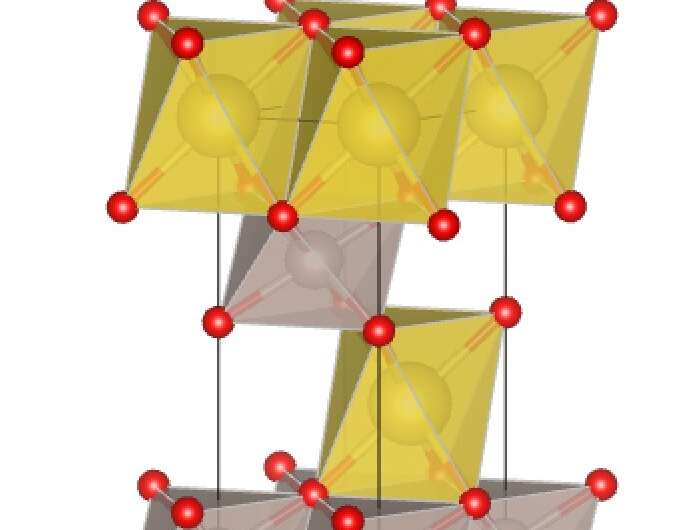The observation of a quantum disordered ground state in a triangular lattice magnet

Magnetic materials with a triangular lattice have been the focus of numerous research studies, as theoretical predictions suggest that they could exhibit spin liquid states. These are quantum phases of matter that present interesting characteristics, such as quantum entanglement and fractionalized excitations.
While there have been numerous experimental efforts aimed at observing these fascinating phases in materials with a triangular lattice, this has so far proved to be very challenging. A key reason for this is that weak spin-orbit coupling and other perturbations in these materials typically result in conventional spin freezing or magnetic states.
Researchers at University of California, Boston College, Oak Ridge National Laboratory and the National Institute of Standards and Technology were recently able to produce a quantum disordered ground state in the triangular lattice-magnet NaRuO2. Their findings, published in Nature Physics, suggest that this state was enabled by the cooperative interplay between spin-orbit coupling and correlation effects in the magnetic material.
“We have been studying triangular lattices for a long time, searching for materials that host what we call quantum disordered ground states,” Stephen D. Wilson, one of the researchers who carried out the study, told Phys.org. “These are states where the magnetic moments on each atom, each sitting within a network of edge-sharing triangles, fail to order or freeze into place even at absolute zero. This failure to order is nominally due to quantum fluctuations which continuously scramble the moments and serve to define a new, intrinsically disordered and dynamic magnetic ground state.”
One approach to realize quantum ground states in materials involves identifying effective strategies to entangle the orbital degree of freedom of individual electrons with their spin degree of freedom. This can ultimately be achieved by carefully combining different elements together, for instance including ruthenium (Ru) in compounds, which was also included in the team’s NaRuO2 sample.
“A major challenge was to make the material we were interested in, NaRuO2, cleanly,” Wilson explained. “To really test what is going on in the realm of quantum magnetism, you really need to remove extrinsic factors like chemical impurities as much as possible. Once we had made NaruO2 with sufficient quality, there were several experiments we could perform, all of them uncovering a little bit more about the physics of what is going on. In other words, you need several different windows to form the whole picture of a complicated material.”
After they realized their clean NaRuO2 sample, Wilson and his colleagues thus proceeded to conduct a series of tests and experiments to better understand its underlying physics. They first examined it using basic bulk characterization methods, for instance measuring its magnetic susceptibility and heat capacity down to very low temperatures.
“We also conducted more advanced experiments like inelastic neutron scattering and muon spin relaxation measurements,” Wilson said. “All these probes tell us a little bit about what the magnetic moments in NaRuO2 do as you cool toward its ground state, each at different length and time scales. When the aggregate picture shows you that the magnetic moments fail to order and instead fluctuate as you cool to temperatures far below those where it should, then you can start to paint a picture of a quantum disordered ground state.”
The experiments conducted by Wilson and his colleagues showed that their carefully designed NaRuO2 sample exhibited an inherently fluctuating magnetic ground state. At low temperatures, spin excitations in the material produced a metal-like term in its heat capacity and a series of continuous excitations in its neutron scattering, which resembled those associated with spin liquid states previously observed in magnets with a triangular lattice.
“Our work demonstrates that triangular lattices built from spin-orbit entangled transition metal ions (e.g., Ru) can be very interesting, and most importantly, the anisotropic interactions necessary to destabilize conventional magnetic order can be realized in real materials,” Wilson said. “We show that this can happen even in materials where the strength of magnetic exchange coupling is nominally pretty strong, which is the case in NaRuO2.”
Recent theoretical studies placed NaRuO2 is a strict ferromagnetic regime, meaning that the dominant interactions in the material should drive all the moments to point parallel to one another. While ferromagnetism would be fairly easy to detect, the findings gathered by Wilson and his colleagues suggest that it is not there, but rather that something else is going on inside this compound.
In the future, new studies could help to better understand the physics of this fascinating triangular lattice-magnet, potentially helping to solve this mystery. In addition, the recent work by this team of researchers could inspire new studies aimed at observing quantum spin liquid states in other magnets with a triangular lattice.
“Our next step will be to try and make single crystals of this material,” Wilson added. “We can gain a lot more information about the physics driving this unusual material once we can explore its inherent anisotropies and other experiments become possible once single crystals are attainable. The next big question is what type of quantum disordered magnetic state NaRuO2 forms—one wants to ideally move beyond simply defining what the state isn’t and instead start to paint as more precise experimental picture for what the magnetic ground state is.”
More information:
Brenden R. Ortiz et al, Quantum disordered ground state in the triangular-lattice magnet NaRuO2, Nature Physics (2023). DOI: 10.1038/s41567-023-02039-x
© 2023 Science X Network
Citation:
The observation of a quantum disordered ground state in a triangular lattice magnet (2023, May 25)
retrieved 25 May 2023
from https://phys.org/news/2023-05-quantum-disordered-ground-state-triangular.html
This document is subject to copyright. Apart from any fair dealing for the purpose of private study or research, no
part may be reproduced without the written permission. The content is provided for information purposes only.
For all the latest Science News Click Here
For the latest news and updates, follow us on Google News.

